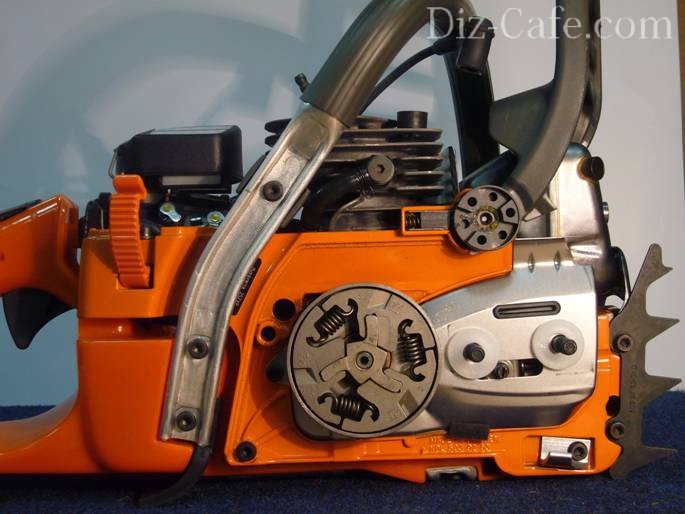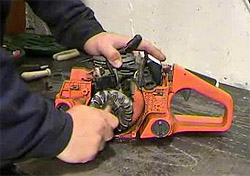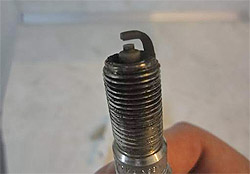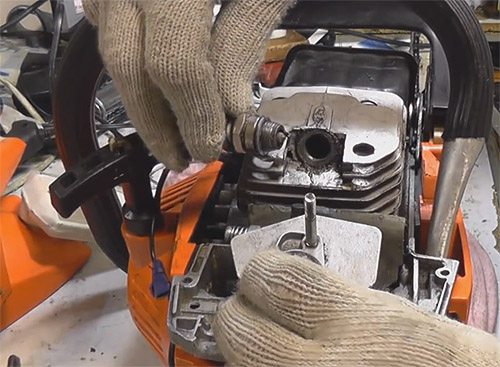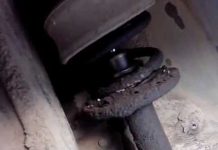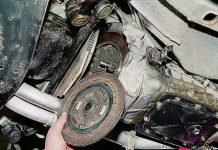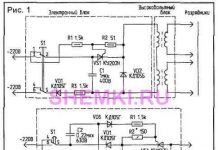It often happens that during prolonged operation, the walls of the exhaust pipe are covered with carbon deposits, which prevents the free exit of exhaust gases.
In this case, remove the muffler (if possible) and wash it with detergents, then dry thoroughly with a hairdryer.
ATTENTION! Carbon deposits contain carcinogens. During dry brushing, it can enter the lungs and pose a threat to your health.
Carbon deposits are usually caused by an incorrect gasoline-oil ratio or the use of poor quality and incompatible oil.
Carefully read the instruction manual for your chainsaw to prevent this from happening in the future.
The worn out cylinder and piston, the appearance of scratches and seizures on their surface, wear of the piston rings or crankshaft bearings - all these are very serious damages. As a result, they lead to a pressure drop in the cylinder. In this case, it will be very difficult to start the engine.
Without disassembly, you can check the state of the CPG as follows. Remove the muffler and look out the window that opens. Part of the cylinder surface will be visible.To obtain information about the state of the CPG, the compression in the engine is measured using a compression gauge, which must be installed in the spark plug hole. Turning the crankshaft (you can use a starter), measure the readings of the device. Compressor readings must be at least 8-9 kgf / cm2 (or 0.8-0.9 MPa).
If there is no compression gauge, you can estimate the presence of compression by eye by simply plugging the hole in the plug socket with your finger and pulling the starter, as shown in the photo below:
Coked piston rings or wear can be the cause of low compression.
Each instruction manual indicates the need to monitor the condition of the chain lubrication system.
Typically, system malfunctions occur due to clogged channels through which the lubricant is supplied. If there is a slight leakage of oil, you can continue to operate. But if the oil leaks are large enough, then you need to check the tightness of the connection of the pipes to the pump unions. The leak can be eliminated by using a sealant or by replacing the tubes.
You should also pay attention to the condition of the oil pump. If there are cracks in its housing, replacement is required.
VIDEO
If the chain brake does not work, then the reason may be contamination of the brake band with grease or sawdust with tree resin or under the cover space.
The problem can be corrected by cleaning the dirt and replacing the brake band.
***
With all the desire, the chainsaw cannot be classified as a complex device. Moreover, the simplicity of the design is its hallmark. But repairing a chainsaw can still be time-consuming. The difficulty lies not directly in repairing the chainsaw with your own hands, but in the accurate diagnosis of the malfunction. One sign of inoperability can be due to many reasons. Therefore, before disassembling the engine or carburetor, it is necessary to thoroughly analyze the symptoms of the malfunction. No instructions for repairing a chainsaw on your own can replace simple logic.
A chainsaw is a tool that cuts wood with a closed chain and is equipped with a two-stroke gasoline internal combustion engine. The ability of the chain saw to operate continuously for a certain amount of time is the main differentiating ability to which you should pay attention.
The main structural units of a chainsaw are: a chainsaw tire, a chain and a gasoline engine that drives the chain and tire. According to the scope and functionality, the chainsaws are divided into the following categories: professional, semi-professional and domestic amateur.
Amateur chainsaws are used mainly in everyday life, for garden work in the village or at their summer cottage. Such saws are very light in weight (3-4 kilograms without a chain and tire), compared to their own older brothers, their vibration is very low, which makes working with this device quite comfortable. Household chainsaws, first of all, are designed for a short period of use (about 5 hours per week), the motor power is small, but these disadvantages are compensated for by the ease of use. With the help of household chainsaws, most often summer residents do a little work - harvesting, firewood, cutting garden trees and pruning branches.
With a semi-professional chainsaw, you can easily complete a wider scope of work - from repairing on your site to logging. The time of continuous operation of such a saw is 2-3 hours a day. The power of the gasoline engine in semi-professional devices has been increased.You can achieve maximum productivity, block trees with medium and small trunk diameters. Often semi-professional chainsaws are used for cutting knots. The only difference between such devices from professional ones is that they cannot be used continuously throughout the working day.
Professional chainsaws are mainly used in logging and industry. The engine power of professional chainsaws is designed to cut trees of any size and diameter. Such chainsaws are made of wear-resistant material and have a particularly strong chain, which allows them to work continuously for 8-16 hours.
All chainsaw breakdowns are conventionally divided into two groups: engine malfunctions with all its systems and assemblies (fuel supply system, ignition, exhaust system, cylinder-piston group) and malfunctions of other assemblies (lubrication system, clutch, tire, chain brake).
Violations in the functioning of chainsaw engines occur quite often, it is their correction and detection that takes users most of the time. They boil down mainly to the following manifestations: the engine does not start, the engine starts, but stalls or does not work at all, the engine does not develop power, that is, it works normally at idle, but stalls under load.
When repairing a chainsaw, it is calm with your own hands, you need to act by the method of exclusion - check all possible causes of breakdown one by one, starting with those whose diagnosis and elimination will take you less time.
Almost all types of engine problems listed above can be caused by ignition system failures. If they occur, it is recommended to start troubleshooting with a candle. This is justified by the fact that its condition will also provide useful information about the functioning of the fuel system. If a problem occurs, remove the plug and inspect it.
When the spark plug is dry, then most likely the problem is not in the ignition system, but in the failure of the fuel mixture to enter the cylinder. You can wrap the spark plug back and grab the fuel system. When the spark plug is splashed with a fuel mixture, there is an excess of it. This can be caused by a misalignment of the carburetor or a violation of the starting rules. The spark plug must be wiped off and dried by draining the cylinder, then shut off the fuel supply and operate the starter to remove excess fuel. Then reinstall the plug and start again.
Perhaps, in your case, the ratio between gasoline and oil in the mixture is disturbed, the carburetor is not adjusted, or low-quality oil is used. Rinse the candle in gasoline, clean the carbon deposits with a needle or an awl, clean the electrodes with a fine sandpaper and reinstall. Even when repairing a goodluck chainsaw with your own hands, which consists in checking the spark plug, there is good reason to believe that the faults are in the fuel system, you need to check the spark plug for the presence of a spark.
If there is no spark, you just need to replace the spark plug. The reasons for the absence of a spark can also be hidden in a faulty ignition module or in violations of the gap between the flywheel magnetic circuit and it. The distance should be 0.2 millimeters. A gap violation is especially likely if you disassembled the saw before removing the ignition module and flywheel. The gap must be set using a gasket that is 0.2 mm thick, placed between the ignition module and the flywheel boss. The defective ignition module must be replaced.
If it has been established by inspection of the spark plug that no fuel enters the cylinder, all the reasons for this must be considered. In particular: non-flow of fuel from the tank due to the clogged hole in its lid, while a vacuum is created in the tank, which prevents fuel from flowing out; insufficient flow or non-flow of fuel from the carburetor into the cylinder; contamination of the fuel filter, which is installed in the tank.
Insufficient fuel supply or the absence of the correct ratio between air and fuel, which are mixed in the carburetor, occurs for the following reasons: due to an unregulated carburetor, clogged air filter, clogged filter mesh or carburetor channels.
Chainsaw repair, as a rule, is not complete without cleaning the air filter, since it becomes dirty quickly enough. When this happens, the ingress of air into the carburetor is reduced, at the outlet the fuel mixture is too rich, and this in turn disrupts the normal functioning of the engine. The dirty filter must be removed for cleaning very carefully so that dirt does not get into the carburetor from it. Clean the filter or wash in water and detergent, dry and reinstall.
Correct the misalignment of the carburetor by adjusting it. This can be done with three screws - minimum and maximum speed. Carry out the adjustment in strict accordance with the instructions for repairing the chainsaw, non-observance of which often leads to engine damage. Some chainsaw manufacturers leave one adjusting screw to exclude unwanted intervention by inexperienced users in the functioning of the carburetor.
If the carburetor adjustment did not help, it is recommended to clean the filter mesh and channels, and also check the membrane for integrity. The carburetor is one of the most complex chainsaw devices, therefore, it is necessary to start disassembling and cleaning it with an understanding of the responsibility of this operation. This unit consists of a large number of small parts that have the unpleasant feature of jumping out of their places unnoticed and getting lost irretrievably, so after disassembling this capricious device it may not be possible to assemble it.
The cause of a motor malfunction, especially if it functions normally at low speeds and stalls under load, is the clogging of the spark arrester of the muffler with combustion products, which prevents normal exhaust. In this case, do-it-yourself repair of a Husqvarna chainsaw consists of removing the muffler, if it is collapsible, then disassembling it, and wet cleaning the unit from carbon deposits using a detergent.
After washing, dry the non-separable muffler with a hairdryer. Remember that soot contains substances that are carcinogenic, and dry cleaning, after which they may be inhaled, is unacceptable. When removing the muffler, plug the engine outlet with a clean cloth.
The muffler can become clogged for the following reasons: due to the use of a fuel mixture with a large amount of oil (the oil level is recommended by the manufacturers), the use of low-quality oil or oil, which is not intended for two-stroke engines.
The most serious are damage to the cylinder-piston group of the chainsaw. This is the worn out piston and cylinder, scuffs and scratches on their surfaces, sinking in the piston ring grooves and their wear, as well as wear on the crankshaft bearings. In the usual way, these malfunctions provoke a drop in the pressure level in the cylinder and the impossibility of starting the engine in the future, or its inability to deliver full power.
There are several ways that help assess the condition of the cylinder-piston group. Remove the muffler and look out the window where you can see part of the side of the unit. Despite the limited overview, a general understanding of the CPG can be obtained.
VIDEO
For a workable chainsaw, the last indicator should be in the range of 0.8-0.9 MPa. With its fall, the power of the engine also decreases. At a pressure level of 5 atm, the engine can and will work, but at idle speed.
It will be possible to accurately assess the state of the CPG only after repairing the saw-free parterre with your own hands, which consists in disassembling the engine - disconnecting the crankcase from the cylinder and removing the piston. If the latter has seizures, deep scratches or chips, it must be replaced. If the cylinder surface is damaged or worn out, there is a chance to bore it to the repair size.Low compression is caused by coking and piston ring wear. Serviceable rings are always clean from carbon deposits, sit loosely in the piston groove and press tightly against its inner surface.
Rare do-it-yourself Ural chainsaw repair manuals do without mentioning the breakdowns of the chain lubrication system, which are quite common. They usually manifest themselves as insufficient or non-supply of lubricant to the chain and in the formation of oil leaks. If the chain is dry, first of all, it is necessary to inspect the channels through which the oil is supplied to the tire and clean them. Their clogging is not uncommon.
If there is a significant leakage of oil (a small level of leakage is considered normal), it is recommended to check the tightness of the connection to the pipe fittings of the pump. They can crack or fall off. In addition to smudges, a violation of the tightness of the oil line can also provoke insufficient lubrication of the chain. The pump will suck in air, which will definitely affect its performance. It is customary to eliminate such violations by sealing the tubes with a sealant or replacing them. The most serious malfunction of the lubrication system is cracks that form in the oil pump housing. It needs to be replaced in this case.
Some parts of the chainsaw, which are subject to natural wear and tear, must be replaced after a certain period of useful life. Their breakdown is a regularity and not at all a malfunction. Wearing parts include a tire, a chain, a drive sprocket, anti-vibration system units and others.
If you do not repair your husqvarna chainsaw with your own hands and replace wearing parts in time, then their excessive wear will affect other parts of the chainsaw in the most negative way. In particular, if the drive sprocket and tire are not changed in time, then the increased vibration will badly affect the crankshaft bearings. The limit for the depth of the sprocket teeth must be up to 0.5 millimeters.
Although sprockets in practice often operate until wear of 1 millimeter or more, without suspecting that this causes an increase in the loads on the crankshaft bearings, accelerated failure. When three or four chains are worn out, you need to change the tire directly, if its wear reaches its limit by this time.
Chainsaw bar wears especially in the areas where cutting occurs most often, usually on the underside of the guide bar. Any time the chain is changed, the bar must be flipped 180 degrees around the horizontal axis for even wear.
Now you know that you can troubleshoot a chainsaw with your own hands. To do this, you should always have a manual for the repair of chainsaws at hand. And in order to finally understand this difficult matter, we invite you to watch a video about repairing a chainsaw, which will help to consolidate all the acquired knowledge in practice.
The chainsaw is a worthy replacement for hand saws and axes. Today, this tool is available in almost every household - it is indispensable for setting up a personal plot, construction and repair work. Intensive use and improper care of the tool can lead to premature failure. However, the owner of the chainsaw does not have to go to the workshop right away - many of the faults that can happen to her during operation are quite realistic to eliminate on their own.
Correct diagnosis is essential for a successful repair. Therefore, in order to determine why the chainsaw failed and, most importantly, how to make it work again, you first need to know the features of its design.
It should be noted that it does not differ in particular complexity, since it includes:
engine (two-stroke gasoline);
functional part (saw bar and chain);
systems that ensure the joint operation of these two units (ignition, filtration, lubrication, etc.), that is, the tool as a whole.
In order to simplify the diagnosis of malfunctions, it is customary to distinguish them into two main categories:
engine malfunctions;
malfunctions of other parts of the chainsaw.
Most often, failures occur in the engine systems, however, the rest of the tool, due to intensive use or improper care, can fail at any time. How to determine exactly where the breakdown occurred? Simple logic will help us with this.
If the problem is in the engine, it will:
do not start;
deafen;
work unstable;
overheat;
smoke;
develop insufficient power.
As for all other malfunctions, as a rule, they manifest themselves with a normally operating motor.
If your chainsaw won't start, the first thing to do is to check for a mixture of fuel in the tank. By the way, it must be prepared in the proportions indicated by the engine manufacturer, otherwise the instrument will simply not start.
After verifying that the fuel mixture is correct and available, the ignition system should be checked. To do this, you need to inspect the spark plug.
Her condition can say a lot:
indicates that the fuel mixture does not enter the carburetor, which means that the problem is not in the ignition;
is the result of an overabundance of the fuel mixture, which lies either in a violation of the engine starting algorithm or in an incorrect carburetor adjustment;
this is a signal about the presence of low-quality oil in the engine lubrication system, incorrect carburetor settings, or an incorrectly prepared fuel mixture.
If the spark plug is splashed with fuel, wipe it thoroughly after removing it. The fuel supply system should also be cleaned. To do this, it overlaps, after which the starter is turned on. A carbonized candle must be carefully cleaned with an awl and emery.
When checking the spark plugs, you should pay attention to the distance between the electrodes (the normal gap is 0.5-0.65 mm), as well as the condition of the gasket and the presence of a spark. A damaged or worn gasket will have to be replaced, and the spark can be checked by putting on the ignition cable, connecting the cylinder and plug nut, and starting the starter.
If the discharge does not occur, the plug must be replaced. In the event that a spark does not appear with a new candle, then the problem is in the connection to the high-voltage wire or in it itself.
If the fuel mixture does not flow into the cylinder, but the spark plug is working properly, this may mean that:
Clogged fuel filter.
To clean this unit, remove the fuel hose and check the jet. If it is weak, the filter must be removed through the filler hole of the fuel tank and cleaned or replaced if completely worn out.
As a preventive measure, it is recommended to replace the fuel filter at least once every 3 months.
This is nothing more than a hole in the fuel tank cap, which is cleaned out with an awl.
The fuel mixture is not supplied or is supplied insufficiently.
There may be several reasons for this:
the air filter is clogged (in this case, it must be removed, rinsed with water, dried and replaced);
the carburetor settings are out of order (which means this unit needs to be re-adjusted);
the integrity of the carburetor membrane is broken (must be replaced);
the channels of the carburetor are clogged (it must be disassembled and all parts and assemblies must be cleaned).
If at low speeds the engine of the chainsaw works normally, but at high speeds it starts to stall and smoke, the problem may be hidden in the muffler.
To check the quality of its work, you should do:
dismantling (with the obligatory closing of the outlet);
disassembly (if the muffler is collapsible);
cleaning from carbon deposits using special detergents or dry method;
drying (using a hair dryer);
reassembly and assembly.
Dry cleaning without respiratory protection is not recommended. The carcinogens present in the soot will be released into the surrounding atmosphere in the form of dust, the inhalation of which is extremely hazardous to health.
To prevent clogging of the muffler during the operation of the chainsaw, you should carefully monitor the composition of the fuel mixture and the quality of its components.
If the chainsaw engine does not start or cannot develop normal power, it is likely that sufficient pressure does not build up in the engine cylinder for combustion of the fuel mixture. The reason for this may be the wear of the elements of the cylinder-piston group - the piston, rings, bearings, etc. In order to assess the condition of this unit, it should be visually inspected, having previously removed the muffler.
For a more complete diagnosis, a compression gauge is placed in the spark plug hole of the two-stroke engine of the chainsaw. It measures the compression in the engine. Based on the results of the check, one can judge the state of the CPG, however, the exact facts can only be obtained with a complete disassembly of the unit.
If the piston is chipped or scratched, it will obviously need to be replaced. The same applies to deformed or broken piston rings - for normal engine operation, they must be completely intact and free of carbon deposits.
A properly working carburetor guarantees maximum efficiency of the chainsaw, that is, it is possible to develop full power with the most economical consumption of the fuel mixture. The adjustment of this unit is usually carried out by the manufacturer, but its design provides for the possibility of adjustment already during operation.
The fact that such a setting will have to be performed by the owner of the chainsaw is evidenced by:
Strong vibrations or damage to the protective cover.
CPG wear.
Carburetor clogged.
Inability to start the engine or its spontaneous stops after starting.
Increase in fuel consumption and emissions while decreasing engine power.
Chainsaw carburetor adjustment is carried out in strict accordance with the manufacturer's instructions using three special screws, which are responsible for the maximum ("M") and minimum ("L") revolutions, as well as the idle speed of the engine ("T"). In order to exclude unwanted interference by an inexperienced user with the carburetor operation, some manufacturers install only one idle screw.
Carburetor adjustment is carried out in two stages:
Basic (carried out with the engine off).
Finishing (carried out with a running, pre-warmed engine).
For basic adjustment, screw in screws H and L as far as the stop and back out 1.5 turns. Final adjustments require the engine to warm up for 5-10 minutes at low revs.
The final calibration is performed by unscrewing the idle screw until the minimum engine speed is reached (in this case, its operation must be stable, and the chain must be stationary). If the engine stops at idle speed, the screw must be returned back, and if the saw chain is still in motion, continue turning counterclockwise.
Calibration check is performed by test:
Acceleration (with a smooth press on the accelerator, the engine should quickly pick up speed to the maximum indicator).
Maximum speed (if there is an ignition interruption, screw H should be slightly loosened).
Work at idle speed (the chain should not move, and the engine should pick up speed as quickly as possible).
If the owner of the chainsaw is not familiar with the carburetor device and does not have the tool necessary to calibrate it, contact a specialist.The carburetor is a very complex unit, so any wrong action can lead to irreversible consequences, for example, complete engine failure.
If the diagnostics showed that everything is in order with the engine and its systems, then the cause of the malfunction should be looked for in other units of the chainsaw. The most common problems are:
failure of the starter;
improper operation of the lubrication system;
incorrect operation of the chain brake;
saw chain wear, etc.
If the cause of the tool failure is not visible to the naked eye, as is the case with the engine, it is necessary to perform a thorough diagnosis of the faults and eliminate them in accordance with the manufacturer's recommendations and safety regulations.
VIDEO
The chainsaw has become such a familiar and necessary tool in the hands of a skilled man that if it fails, we begin to feel uncomfortable. But the design of this unit is so simple that we can make almost any repair of its components ourselves. But what is needed and how do you repair a chainsaw with your own hands?
You need to have a very small set of tools for this:
a set of keys (including a special key for spark plugs);
a diagram of the chainsaw device (usually it is included in the delivery set).
You also cannot do without elementary knowledge from the physics course. Add to that the ability to reason logically and you are almost ready to fix your chainsaw.
We will begin the repair with the "diagnosis" - the definition of the malfunction. First you need to unscrew the candle and inspect it carefully. Possible problems are listed below.
Types of spark plugs for chainsaws.
The candle is damp. We make a logical conclusion that the fuel mixture inside the combustion chamber does not ignite. The second reason can be water trapped in the cylinder. In any case, you need to dry the candle, blow out the cylinder. We do the same as when starting the chainsaw. The only difference is that the fuel supply valve must be closed and the throttle valve must be fully open. After that, we put on a cradle from the wire on the candle and check for the presence of a spark by pressing the candle against the cylinder body and trying to start the engine. If the spark is good, the reason may be the fuel - it needs to be replaced. If the spark does not appear or appears unevenly, then the cause of the malfunction should be sought in the ignition system. There may be a breakdown in the high-voltage wire or damage to the spark plug itself. It is enough to try using a spare plug to make sure that the first plug can still be used. If the spare plug does not respond to the start-up test, then the ignition system should be examined more thoroughly.
The candle is dry, but heavily soot-coated. This fact indicates that the balance between fuel and oil is imbalanced (there is too much oil!) Or one of the filters is clogged (fuel or air). Clogged filters first leads to a loss of power of the chainsaw, and then to its complete stop. Dust that gets inside the cylinder cannot be completely burned and settles on the inside of the cylinder in the form of a dense layer of soot.
Chainsaw fuel system: 1 - fuel filter, 2 - carburetor, 3 - manual pre-priming pump.
This drawback is eliminated as follows: the fuel is replaced, the fuel filter is cleaned (according to the instructions), the air filter is washed and dried. The candle itself is mechanically cleaned of soot using an awl, its contacts are cleaned with fine sandpaper.
The candle is dry and clean. Apparently, no fuel enters the cylinder at all. The cause may be either a clogged conductive tube or a problem with the carburetor. It is necessary to clean the fuel line of the chainsaw and check the operation of the fuel pump and carburetor.Repairing the named chainsaw units at home is almost impossible, so they are simply replaced.
Regarding the carburetor of the chainsaw, several important points still need to be clarified: manufacturers minimize the possibility of adjusting it, leaving access only to adjusting the idle speed. But even such a small amount makes it possible to achieve maximum power from the chainsaw.
By adjusting the idle speed correctly, you will notice that the engine runs more reliably.
But it is better to entrust the repair of the carburetor to the service specialists, since it can be done independently only if you have a lot of experience and certain knowledge.
Chainsaw two-stroke engine diagram.
We will assume that you were able to do everything accurately and your chainsaw began to show signs of life, but there are problems with power. It happens very often that the engine works well at idle, but the chain speed increases very slowly when the accelerator lever is pressed, or the chainsaw simply stalls. The problem may be that the exhaust gas outlet is clogged. It is not difficult to eliminate this deficiency.
First you need to unscrew the muffler. The piston must be set to the uppermost position so that it blocks the channel and excludes the possibility of soot getting into the cylinder. And now the soot must be carefully scraped off the walls. You can use both a screwdriver and a thin chisel for these purposes. When cleaning, we try not to make great efforts, as you can easily mechanically damage the cylinder or piston. After removing the plaque, we wipe the cleaned surface with diesel fuel or gasoline, and the muffler can already be screwed on. Before this, the non-separable muffler should be washed with diesel fuel or low-octane gasoline and dried. Removing the soot will increase the power.
It is possible that none of the described home repair methods led to the desired result and the chainsaw still does not work. Most likely, you have a malfunction in the ignition system. It turns out that both the fuel comes in, and the spark on the spark plug is excellent, and the engine refuses to work.
VIDEO
We check the quality of the ignition control as follows: we turn off the spark plug, adjust the gap between the contacts (according to the technical data sheet of the product), connect it to the wire and press it against the cylinder body. And now we observe the moment the spark appears: it should appear at the extreme upper position of the piston. Visually it is noticeable. If deviations exist, then you need to adjust the ignition. It is produced in different ways for different chainsaws, but in general this process resembles ignition adjustment in other two-stroke engines.
Repairing a chainsaw on your own is also permissible in case of problems with the chain brake. It usually happens due to surface contamination with sawdust or lubricants. The wear of the braking band itself is also possible. Simply unscrew the side panel and clean. If necessary, the tape is replaced.
Chainsaw electronic ignition circuit.
Repairing a chainsaw that has problems with the cylinder-piston part involves disassembling the motor and replacing worn parts. This is the most difficult repair, but also the rarest. In modern chainsaws, breakdowns of parts of this group are rare. And this usually happens due to the marriage of the components of the mechanism at the initial stage of operation. During this period, you have the opportunity to get a chainsaw repair under a warranty card, so there is no need to make it yourself.
It should be noted that the main reasons that lead to the breakdown of chainsaws and their subsequent repair include violations of the operating rules provided by the manufacturer. First of all, this is a violation of the ratio of oil and gasoline in the fuel mixture.Very often, users of chainsaws do not even suspect that the prepared fuel mixture loses its properties under the influence of direct sunlight. The fuel changes not only its color but also its lubricating properties. Certain particles do become technically harmful additives that can disrupt the operation of the fuel system of a chainsaw. Hence, the conclusion suggests itself that elementary adherence to maintenance rules will allow extending the trouble-free service life of almost all chainsaws.
A few words must be said about other rules that will avoid repairs for the longest possible period. First of all, you need to have several buses (at least two) and several chains (at least 4) available. The tire should be turned 180 ° after every 3 hours of operation. After another three hours, we also replace the chain. This approach will allow uniform wear of all parts of the saw, which will eliminate distortions and additional stress.
VIDEO
It is constantly necessary to monitor the cleanliness of the entire mechanism and various openings. Clogged holes can cause the vacuum plug to prevent fuel or oil from reaching the required parts freely, causing the chain saw to stop.
Video (click to play).
You should start repairing chainsaws at home only when you have certain skills in carrying out such repairs. Otherwise, such work should be entrusted to the specialists of the company service. Their experience will allow you to quickly diagnose a chainsaw and repair it with high quality.

